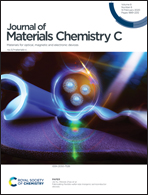Enhancing the coercivity of SmCo5 magnet through particle size control†
Abstract
The SmCo5 rare-earth hard magnet has the largest anisotropy field among all known magnetic materials, 32 MA m−1 (400 kOe), while the obtainable coercivity (Hc) is usually less than 30% of the anisotropy field. The coercivity is enhanced when the grain size (spherical shape) is in the stable single-domain size (SSDS) range. Theoretical calculation predicts the SSDS range of SmCo5 to be 740–870 nm, however, at present, there has been no experimental data supporting this claim. Herein, we used a chemical method for tuning the average particle size (APS) of SmCo5 resulting in sizes ranging from 228 nm to 1191 nm. We find, that the morphology and composition of the precursor plays a decisive role in determining the composition and APS of the final product. A maximum coercivity of 2.6 MA m−1 (33.1 kOe) was obtained for an APS of 823 nm. SEM images and recoil loops demonstrate that samples with high coercivity are homogeneous and the demagnetization process happens simultaneously between multiple phases showing single-phase magnetic behavior. Henkel plots and δM plots verify the existing of strong exchange coupling interaction between particles, resulting in high Mr/Ms ratios. This is the first reported systematic optimization study of the coercivity of SmCo5 based on single-domain theory and the optimized APS matches remarkably well the predicted SSDS range.



 Please wait while we load your content...
Please wait while we load your content...